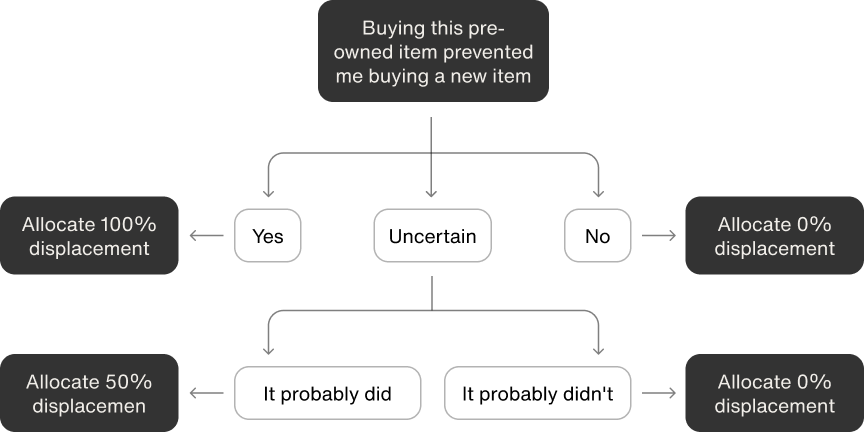Impact
Report 2023
The inside track
on our
methodology
Scroll to discover

1. WHY IMPACT REPORTING?
To ensure that we are really making a difference
But we don’t just want to report on what we’re doing. We want to understand what’s changing in the world because Vestiaire Collective exists. That's where our Impact Reports come in – for full transparency around our environmental and social impact on the world.
So instead of just tracking our activity or emissions, this report analyzes and measures the impact of our business on society, giving us the data and insights we need to keep transforming the fashion system.
2. ACKNOWLEDGMENTS
Special thank you to PwC UK's Sustainability team for their work using impact valuation methods and their help structuring this report. Also, thanks to Goodkids for bringing this report to life.
We also want to thank some of our key partners who also contributed to this report:
The Boston Consulting Group, for coleading with us some consumer insights
Kering, for encouraging us to look into monetization methodologies
Valuing Nature, for providing relevant data sources
3.1 HOW WE DID IT ? METHODOLOGY & DATA SOURCES
Consumer Behavior A
To investigate the behavior of our community of buyers and sellers (and beyond), we conducted a survey in January 2023. Its aim was to refine our calculations around avoided impact data, investigate overconsumption, and to situate Vestiaire’s approach within the second-hand fashion industry, and indeed the industry as a whole. These are the questions and key answers that we used to calculate our displacement rate, investigate what sellers would have done without Vestiaire (to calculate our value-added), and to understand the motivations for selling on Vestiaire.
The survey was emailed to 76,000 Vestiaire Collective consumers, including both buyers and sellers: 37.6% of respondents were both buyers and sellers, 39.3% were buyers only, and 23.1% were sellers only.
The survey had a response rate of 4.7% with 3,589 responses in total.
What we have found
1 Displacement rate: 82% of items purchased on Vestiaire preventing a first-hand purchase
Remember your last purchase on Vestiaire Collective: buying the item second-hand on Vestiaire Collective prevented me from buying a new item (e.g. I bought second-hand instead of new or I won’t need to buy a similar new item for a while)
Agree (79.8%)
Disagree (12.1%)
Not sure (8.0%)
You said you’re not sure. Which of the following best applies to this item?
It probably prevented the purchase of a new item. For example, I didn’t buy any similar new items for quite a while afterwards. (63%)
It probably did not prevent the purchase of a new item, because I purchased something similar around the same time or soon afterwards. (37%)
Calculation Methodology

The % are for responses : “Strongly Agree” and “Agree” for the respective questions
2 Seller behavior: 84% of sellers want to give a second life to their items
Why did you decide to sell second-hand fashion items on Vestiaire Collective? To give a second life to the items I don't wear
Strongly Agree (46%)
Agree (38%)
Neutral (9%)
Disagree (3%)
Strongly Disagree (4%)
3 61% of users are encouraged with Vestiaire Collective to look at second-hand in other areas of their lives
Platforms like Vestiaire Collective encourage me to look at second-hand in other areas of my life
Strongly Agree (26%)
Agree (35%)
Neutral (23%)
Disagree (9%)
Strongly Disagree (7%)
4 68% of buyers are hunting for the perfect piece
I enjoy treasure hunting for the perfect piece
Strongly Agree (33%)
Agree (35%)
Neutral (19%)
Disagree (7%)
Strongly Disagree (7%)
Assumptions and considerations:
The assumption behind the positivity of our displacement rate is that from a sustainability perspective, preventing a first-hand purchase is seen as desirable in order to avoid the large environmental impacts that are derived from the production of new fashion items. We recognize that more research may be needed to shape and quantify the link between reducing demand for first-hand items and reducing production. When calculating additionality, the idea of the item being given a second life or not was based on first-order effects in the near future. That is, if the item would have otherwise been donated to charity, the assumption was that it would have been bought by someone who would wear it or donated to someone in need. If the item would have otherwise been given to a friend/family, the assumption was that those people would have worn it and not left it unworn in their wardrobes, or thrown it away. For those who answered ‘other’, the option was available to provide a written explanation of what they would have done. The majority of these people said that they would have sold the item on a different online platform. For people who said that they would have kept the item in their wardrobe without wearing it, the assumption was that it would be kept there indefinitely and not given a second life whilst in their ownership for the near-term.
3.2 HOW WE DID IT ? METHODOLOGY & DATA SOURCES
Environmental Impact B
How we determined environmental costs
In 2020, Coopérative Mu carried out an assessment of the environmental footprint of our operations. This assessment followed a life cycle analysis (LCA) methodology, covering all the stages of a sale: online deposit and purchase, the shipping of the package, warehouse and packaging processes.
The outputs of this work included life cycle inventory and life cycle impact assessment data that were leveraged for this impact report. PwC valuation coefficients were applied to these datasets across the impact areas of greenhouse gases (GHGs), air pollution, water pollution, water consumption and land use.
The valuation coefficients convert the measurable environmental outcomes of our operations, expressed in kgCO2e or m3 of water consumed, into monetary terms, expressed in Euros. These monetary values represent the cost to society of the environmental impacts.
The valuation coefficients have been developed by PwC over the last decade and incorporate science-based estimations of the changes in the natural environment that result from the environmental outcomes, as well as the subsequent impact on people’s wellbeing. Quantifying the change in people’s wellbeing typically relies on non-market economic valuation techniques that look to understand people’s preferences and experiences. For example, asking people directly or indirectly for their willingness to pay to reduce risks to their wellbeing.
The PwC approaches (11) have been extensively peer reviewed and are recognised as market leading. These were the only monetary valuation methods recommended to be considered for the development of the Natural Capital Protocol by its Methodological Review Panel.
The analysis of our environmental impacts also included a comparison of our business model with that of linear fashion. Considerable attention is required when selecting a counterfactual to ensure that the comparison is fair. For this report we have chosen to compare our monetized impact against the cradle-to-gate product impacts of the Kering EP&L (12) , as reported in their use and product end of life study (noting that we have not included any use phase or end of life impacts in our comparison). The Kering EP&L also focuses on the environmental impact of luxury fashion and uses the same valuation methods across the same impact areas.
Assumptions and considerations
The disposal of waste can drive a number of impacts including the release of GHGs and other air pollutants, leachate of pollution into water bodies and soils, and disamenity around disposal sites. In the Kering EP&L these impacts are given their own impact category and presented separately from the impacts of other GHGs, air pollution, water pollution, water consumption and land use. It was not possible to separate out the effect of waste disposal in the Coopérative Mu data and, therefore, waste disposal is not presented separately in Vestiaire Collective’s operational impacts.
This study of the environmental costs of fashion has a focus on luxury. The impacts of fast fashion may look different, reflecting significant differences in fast fashion value chains and consumer behaviour. As a further point of comparison, this would be an important area for future investigation.
How we measure our carbon footprint
Our assessment is based on the GHG Protocol Corporate Standard (13) and covers the three scopes of a company’s greenhouse gas (GHG) emissions.
Our Scope 1 and Scope 2 emissions represent only 1% of our carbon footprint.
Our Scope 1 emissions are direct emissions from heating (natural gas).
Our Scope 2 emissions are indirect emissions from the purchase of electricity and district heating for our offices and warehouses globally.
Our Scope 3 emissions account for 99% of our carbon footprint and represent all indirect emissions (not included in scope 2) that occur in our value chain, including both upstream and downstream emissions.
Our Scope 3 upstream emissions take into account Purchased goods and services, Capital Goods (facilities, IT inventory), Fuel- and energy-related activities not accounted for in Scopes 1 and 2, Upstream transportation and distribution, Waste generated in operations, Business travels and Employee commuting.
Our Scope 3 upstream emissions take into account the use of our platform by consumers (electricity consumption, manufacturing and end-of-life of users' devices).
We have collected data on all the above emissions categories and computed our carbon footprint on the Aktio platform. Depending on available data, we collected either GHG reports directly from our suppliers (e.g. for our carriers), real or estimated physical data (e.g. energy consumption) or monetary data (e.g. spend for the purchase of goods and services).
Our total emissions amount to 20 568 metric tonnes of CO2e in 2022.
How we measure our avoided emissions
Our avoided emissions are the difference between the emissions corresponding to two situations:
Buying on Vestiaire (emissions related to the product only), based on our carbon footprint assessment (see above).
A reference scenario where 82% of the items sold on our platform would have been purchased new (cf. displacement rate). We have calculated the associated emissions of the reference scenario based on data from the European Commission’s Product Environmental Footprint (PEF)(14) on life-cycle assessment impacts of apparel & footwear items.
3.3 HOW WE DID IT ? METHODOLOGY & DATA SOURCES
Socio-economic Impact C

3.4 HOW WE DID IT ? METHODOLOGY & DATA SOURCES
Social impact D

4. THE SOURCES
Sources
(1)
Patagonia's ex CEO Ryan Gellert
https://www.treehugger.com/patagonia-sells-used-clothing-alongside-new-5089233
(2)
Boston Consulting Group (2020), The Consumers Behind Fashion’s Growing Secondhand Market
https://www.bcg.com/publications/2020/consumer-segments-behind-growing-secondhand-fashion-market
(3)
European Environmental Agency, Textiles and the environment: the role of design in Europe’s circular economy
https://www.eea.europa.eu/publications/textiles-and-the-environment-the
(4)
https://www.gov.uk/government/publications/greenhouse-gas-reporting-conversion-factors-2021
(5)
Waterwise, Assumed a 10 minute shower, with the average shower using 12 Litres per minute
(6)
Vestiaire Collective 2022 Impact Report
https://fashion-sustainability-report.vestiairecollective.com/2022/fashion-sustainability-report-2022
(7)
Calculated using Insee population and total employed/unemployed in the economically active population
(8)
Boston Consulting Group (2022), What an Accelerating Secondhand Market Means for Fashion Brands and Retailers
https://www.bcg.com/publications/2022/the-impact-of-secondhand-market-on-fashion-retailers
(9)
https://wearzeitgeist.com/fashion-sustainability-ethics/fast-fashion-statistics#:~:text=Three%20out%20of%20file%20 fast,shift%20their%20mindset%20around%20apparel.
(11)
PwC UK (2015 - 2022), Natural Capital: risks and opportunities
https://www.pwc.co.uk/naturalcapital (Accessed 2022)
(12)
Kering (2022), What is an Environmental P&L?
https://www.kering.com/en/sustainability/measuring-our-impact/our-ep-l/what-is-an-ep-l/
(13)
GHG Protocol Corporate Standard
https://ghgprotocol.org/corporate-standard
(14)
European Commission’s Product Environmental Footprint
https://pefapparelandfootwear.eu/whats-behind-the-methodology/#categories
(15)
Calculated based on European Commission calculation for unemployment benefits (based on an average Vestiaire Collective employee, with assumptions including that they had a prior job with salary equal to the average Vestiaire salary)